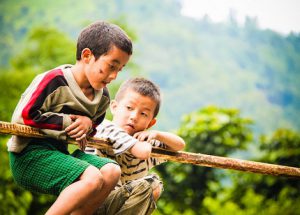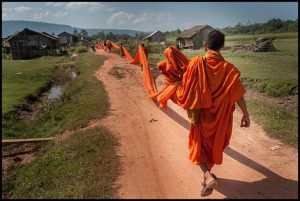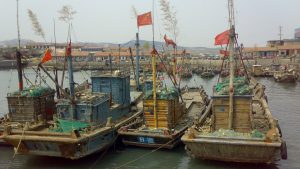It’s hard to find any place flatter than the bird-rich wetland of Maguri Beel high in the Brahmaputra basin in India’s north-eastern Assam state. Patches of grass and lotus pads—home to an array of migratory birds—punctuate a seamless opalescence where the river meets the sky.
So what brings a pair of researchers from the International Centre for Integrated Mountain Development (ICIMOD) all the way down from the alpine valley of their Kathmandu headquarters to bird watch in this horizonless swamp in upper Assam? They are part of the Himalayan Climate Change Adaptation Program (HICAP), an ambitious five-year study of how grassroots communities cope with the accelerating disruptive effects of climate change.
The area around the Maguri wetland in easternmost India, along with the project’s four other study sites around Himalayan rivers in China, Pakistan, and Nepal, typifies the perils of an intensifying hydrological cycle: longer dry spells and stronger, less predictable flood waves. That much has already been established in earlier, region-wide ICIMOD studies.
But when it comes to how these changes play out locally, the picture gets much more complex, as the ICIMOD research team learned from its Assam-based NGO partners, Aaranyak, during their Maguri foray.
The wetland’s species diversity is on the wane, the researchers were told, partly due to habitat destruction from intensifying floods like last year’s deluge. But the birds suffer even more from the impact of local fisheries, which decimate the stocks of small fish that refuel migratory flocks.
As the human population increases along the Brahmaputra, demand for fish is on the rise. And as volatile floods make farming riskier, more and more people turn to fishing. So, fishermen now have to target species so far down the food chain that some even trawl (illegally) with mosquito nets. This pits humans in direct competition with birds for food supplies.
That kind of messy, unquantifiable story—with causes and effects intertwined—typifies the HICAP findings in all five research sites. The results may not be analytically tidy, but they just might provide local communities with more realistic guidelines for how to cope.
Earlier ICIMOD studies make a powerful case for cutting back greenhouse gas emissions, but they only begin to prepare for the fallout. Providing practical help to communities will require a finer-grained understanding of climate change impacts.
So ICIMOD climatologists are working to downscale regional models for five Himalayan river sub-basins to project precipitation and temperature changes over the next 35-85 years for areas as specific as just 150 square kilometres. Then water modelers will graft these projections onto the terrain and soil conditions to map runoff patterns and river flows.
That’s the easy part. Much trickier is figuring out how humans will respond to these changes. In all five research areas, local partners like Aaranyak are collecting economic and social data to understand how grassroots communities currently fare and how ready they are to buffer oncoming climate shocks.
“Adaptation to climate change is already happening,” said Nand Kishor Agrawal, who heads HICAP. “If there is a delay in rainfall, people have to fend for themselves. They decide whether to plant this crop or change to that crop.”
Nor is climate the sole driver of such decisions, according to Agrawal. “The market is a big force, too. Which crop, which product will give a higher price, and more return?” The Maguri shift from farming to fishery offers a prime example.

With such an interdependent tangle of driving factors, HICAP researchers don’t expect to paint a clear picture or find easy answers. No matter, as long as they can come up with solutions that work: Which crops can withstand water stress and sell for a decent market price? How to replenish dwindling fish stocks or redeploy fishermen?
One key strategy is to “diversify opportunities to generate income”, according to Dhrupad Choudhury, Agrawal’s boss, who directs ICIMOD’s Adaptation to Change umbrella project. Instead of devoting all their efforts to mono-cropping their most profitable crops, he said, farmers should plant more varieties and simultaneously branch into non-farm labour such as small-scale food-processing.
But such initiatives require technical know-how, access to credit, and support from local government agencies—all of which are in short supply in rural, isolated communities. And a more granular understanding of climate change deliberately undercuts “one size fits all” solutions. Hence the need for an army of ground workers to find and implement optimum solutions for specific localities.
That’s why the ICIMOD research team spends much of its time training and coordinating with research outfits like Aaranyak. Effective solutions, Agrawal is convinced, are as likely to come from a Maguri bird guide as from a desk-bound researcher in Kathmandu.





